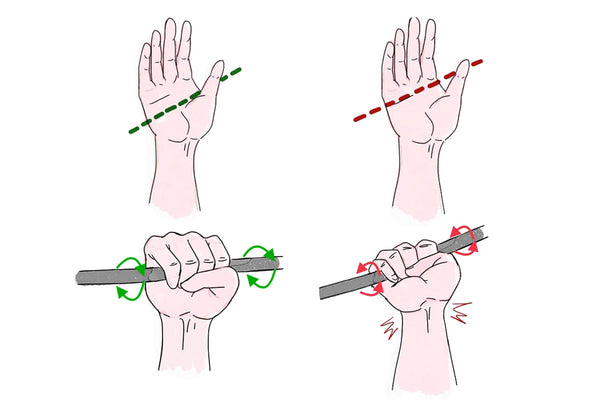The bench press is one of the best full body, compound exercises you can do to build muscle and strength. It primarily works the chest, shoulders and triceps, but also stimulates muscle fibers in the lats, biceps, and glutes.
While the bench press is a staple exercise in just about any weight lifting program, many individuals still struggle to perform the exercise correctly, which is understandable. While the exercise may appear simple, it’s rather intricate and complex, requiring time to refine and perfect your technique.
One of the most common questions people have regarding the bench press is what should the position of their wrists be?
Is it better to bench press with wrists straight or bent back?
We’ll answer that question ahead, but before we answer that question, let’s briefly review the three main types of bench press.
Should My Wrists Be Straight or Bent on the Bench Press?
Simply put, the safest and most effective way to bench press is to use a straight or locked wrist.
When you bench press with bent wrists you’re creating an “energy leak” in the system, thereby reducing force output and making it that much harder on yourself to press the bar up away from your body.
Essentially, the force generated by your chest, shoulders, and triceps can’t travel directly inline to the bar when benching with bent wrists. Since the bar is behind your forearms, the force generated has to make a hard turn at the bent wrist and then find its way into the bar.
In addition to losing power during pressing, benching with bent wrists also leads to wrist pain and potential injury. The bent wrist position drives the weight of the bar into your wrist and forearm, stretching them past their normal range of motion.
When gripping the bar, keep your fist in line with your forearm to create a strong, straight wrist, which maximizes force output and helps protect you from injury and pain.
Different Types of Bench Press
Flat Bench Press
The favorite exercise of all gym rats on International Chest Day (i.e. Mondays), the flat bench press is a staple exercise for developing the pecs and regarded as the top bench press variation for building overall strength and power as it allows you to use the most weight.
Researchers have noted that overall bench press strength is reduced by roughly 25% during incline presses and about 18% in decline variations.
Therefore, if maximum strength is your goal, the flat bench press is your best option. However, that’s not to say that incline and decline variations don’t have their place in your workouts.
Incline Bench Press
The incline bench press is a bench press performed on a bench with a 30-45° incline. The setup and movement pattern are the same as a flat bench press, only the angle of your body is different. The mechanics of the incline press are basically the same except that instead of lowering the bar to your middle-to-lower sternum, you lower the bar to your upper-chest and press it back up over your shoulders.
EMG studies have found that both the flat bench and incline bench press due a fine job of stimulating the fibers of the upper chest (which is a difficult area to develop for most lifters).
Therefore, if you’re looking to create more “lift” in your chest, you’ll want to make sure both incline and flat bench press variations are in your training program.
Decline Bench Press
As the name implies, the decline bench press is performed on a decline, usually around 10-15 degrees below parallel.
Note: It’s generally recommended to use a decline bench with leg attachments so you don’t slide down the bench while pressing the weight.
The decline bench press is typically used to help emphasize the muscle fibers of the lower chest as well as the triceps. This bench press alternative is a favorite of lifters who tend to experience shoulder irritation when performing flat or incline presses as the decline angle of the exercise is a bit more shoulder-friendly since it moves stress off the shoulders.






